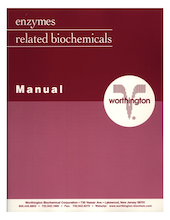For our international customers, please be advised that orders cannot be placed through our website by customers in countries with International Distributor representation.
Enzyme Manual
The Worthington Enzyme Manual contains technical information on enzymes including molecular weight, composition, activators, specificity, inhibitors, stability, assay method, optimum pH, ionic effects, temperature effects, extinction coefficient, and isoelectric point, as well as applications and extensive references.

DNA polymerase I participates in the DNA replication of prokaryotes. DNA chain growth is in the 5’ to 3’ direction with addition at the 3’ hydroxyl end. The new chain is base-paired with the template…
Product has been discontinued. Contact: marketing@worthington-biochem.com for more information.
Taq DNA polymerase is a DNA-dependent polymerase. Taq refers to Thermus aquaticus, the bacteria from which this thermostable polymerase was first isolated. The enzyme exhibits optimal activity at 75°…
Bacteriophage T4 DNA polymerase is a DNA-directed 5’ to 3’ DNA polymerase. It is the product of gene 43 of the bacteriophage T4, and is therefore often referred to as T4 gp43 DNA Polymerase.
Elastase is a serine protease that also hydrolyzes amides and esters. It is produced in the pancreas as an inactive zymogen, and activated in the duodenum by trypsin. The following information…
Elastin is the insoluble, elastic protein of high tensile strength found
in intercellular spaces of the connective tissues of large arteries, trachea,
bronchi and ligaments. It has been reviewed by…
Endoproteinase-Lys-C is a serine endoproteinase that specifically cleaves peptide bonds at the carboxyl side of lysine. It has a molecular weight of 30,000 daltons and is used in optimal pH…
Galactose oxidase (GAO) is a fungal secretory enzyme that catalyzes the oxidation of a range of primary alcohols to the corresponding aldehyde, with reduction of dioxygen to hydrogen peroxide.
Beta-galactosidase (Lactase) catalyzes the following hydrolysis:
β-Galactosidases are widespread, in microorganisms, animals and plants. That from the Escherichia coli strain K12 has been…
Glucose oxidase, a flavoenzyme, catalyzes the following reaction:
Bright and Porter (1975) have reviewed the kinetic behavior and redox states of the flavin coenzyme. Bentley (1963) has reviewed…
Glucose-6-phosphate dehydrogenase (G6PD) is a regulatory enzyme catalyzing the first step of the pentose phosphate pathway: oxidation of glucose-6-phosphate using NADP+ and/or NAD+.
…
β-Glucosidases catalyze the hydrolysis of glucosides:
Emulsin originally was the term applied to the extract of sweet almonds. It remains as the historical prototype of β-glucosidase. Many other…
β-Glucuronidase hydrolyzes conjugated glucuronides.
It is ubiquitious in animal lysozymes.
The enzyme has found wide application in determining urinary steroids.
Characteristics of β-…
Glutamate decarboxylase (GAD) is a pyridoxal enzyme that catalyzes the removal of the carboxyl group of L-glutamic acid adjacent to the α-amino group to produce γ-aminobutyric acid and carbon dioxide…
Glyceraldehyde-3-phosphate dehydrogenase (GAPD) catalyzes the following reaction:
See Hill et al. (1975a), Fife and Szabo (1973), and Francis et al. (1973).
GAPD is a key enzyme in intermediary…
Glycerol dehydrogenase catalyzes the following reaction:
The primary interest in this enzyme is for the determination of glycerol in biological fluids: reduction of NAD is measured by change in…
Glycerol kinase (GK) catalyzes the following reaction:
Glycerol kinase has been reviewed by Thorner and Paulus (1973a). The activity is found widely in nature. In microorganisms GK makes…
Bovine erythrocyte hemoglobin is used as a substrate for pepsin and other proteases.
Hemoglobin is composed of one globin plus four hemes; heme consists of protoporphyrin IX and ferrous iron. The…
Most traditional methods published for isolating hepatocytes use crude and partially purified enzyme preparations including various types of collagenase and other proteases. More recently the use of…
Hexokinase catalyzes the reaction:
Hexokinases have been isolated from the yeast cell in two distinct forms, designated P-I and P-II (Schulze et al. 1969). These are separate,…



